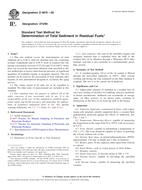Potrebujeme váš súhlas na využitie jednotlivých dát, aby sa vám okrem iného mohli ukazovať informácie týkajúce sa vašich záujmov. Súhlas udelíte kliknutím na tlačidlo „OK“.
ASTM D7112-12
Standard Test Method for Determining Stability and Compatibility of Heavy Fuel Oils and Crude Oils by Heavy Fuel Oil Stability Analyzer (Optical Detection)
Automaticky preložený názov:
Štandardná skúšobná metóda pre stanovenie stability a kompatibility ťažkých vykurovacích olejov a surových olejov o ťažký vykurovací olej stability Analyzer (Optical Detection)
NORMA vydaná dňa 1.11.2012
Informácie o norme:
Označenie normy: ASTM D7112-12
Poznámka: NEPLATNÁ
Dátum vydania normy: 1.11.2012
Kód tovaru: NS-37589
Počet strán: 11
Približná hmotnosť: 33 g (0.07 libier)
Krajina: Americká technická norma
Kategória: Technické normy ASTM
Kategórie - podobné normy:
Anotácia textu normy ASTM D7112-12 :
Keywords:
asphaltene precipitation, asphaltenes, compatibility, crude oil, heavy fuel oil, insolubility number, P-value, residual oil, solubility blending number, solvent equivalent, stability, stability reserve, ICS Number Code 75.160.20 (Liquid fuels)
Doplňujúce informácie
| Significance and Use | ||||||||||||||
|
5.1 Automatic determination of stability parameters using a light back-scattering technique improves accuracy and removes human errors. In manual testing, operators have to visually compare oil stains on pieces of filter paper to determine if asphaltenes have been precipitated. 5.2 Refinery thermal and hydrocracking processes can be run closer to their severity limits if stability parameters can be calculated more accurately. This gives increased yield and profitability. 5.3 Results from the test method could be used to set a standard specification for stability parameters for fuel oils. 5.4 The compatibility parameters of crude oils can be used in crude oil blending in refineries to determine, in advance, which crude oil blends will be compatible and thus can be used to minimize plugging problems, unit shut downs, and maintenance costs. Determination of crude oil compatibility parameters also enables refineries to select crude oil mixtures more economically. 5.5 This test method can measure stability and compatibility parameters, and determine stability reserve on different blends for particular applications to optimize the blending, storage, and use of heavy fuel oils 1.1 This test method covers an
automated procedure involving titration and optical detection of
precipitated asphaltenes for determining the stability and
compatibility parameters of refinery residual streams, residual
fuel oils, and crude oils. Stability in this context is the ability
to maintain asphaltenes in a peptized or dissolved state and not
undergo flocculation or precipitation. Similarly, compatibility
relates to the property of mixing two or more oils without
precipitation or flocculation of asphaltenes.
1.2 This test method is applicable to residual products from atmospheric and vacuum distillation, from thermal, catalytic, and hydrocracking processes, to products typical of Specifications D396, Grades No. 5L, 5H, and 6, and D2880, Grades No. 3-GT and 4-GT, and to crude oils, providing these products contain 0.05 mass % or greater concentration of asphaltenes. 1.3 This test method is not relevant to oils that contain less than 0.05 % asphaltenes, and would be pointless to apply to unstable oils that already contain flocculated asphaltenes. 1.4 The values stated in SI units are to be regarded as standard. No other units of measurement are included in this standard. 1.5 This standard does not purport to address all of the safety concerns, if any, associated with its use. It is the responsibility of the user of this standard to establish appropriate safety and health practices and determine the applicability of regulatory limitations prior to use. |
||||||||||||||
| 2. Referenced Documents | ||||||||||||||
|
Podobné normy:
Historická
1.10.2013
Historická
15.6.2013
Historická
1.5.2010
Historická
15.4.2009
Historická
15.4.2012
Historická
1.11.2012



 ASTM D4815-13
ASTM D4815-13 ASTM D4860-13
ASTM D4860-13 ASTM D4868-00(2010)..
ASTM D4868-00(2010).. ASTM D4870-09
ASTM D4870-09 ASTM D4952-12
ASTM D4952-12 ASTM D4953-06(2012)..
ASTM D4953-06(2012)..
 Cookies
Cookies
